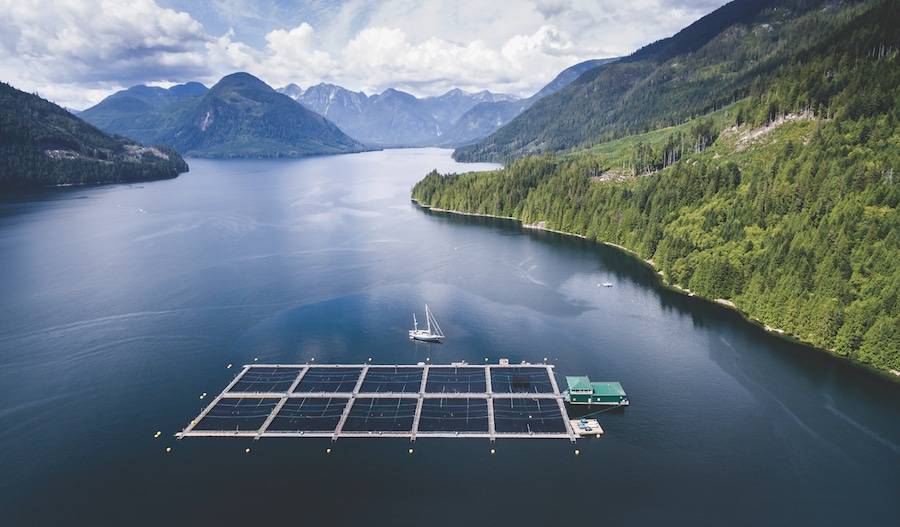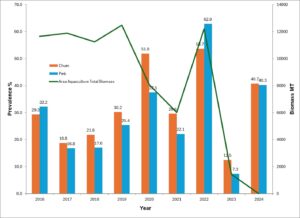CAMPBELL RIVER, BC – One of the most repeated myths around salmon farming in British Columbia goes something like this: “When salmon farms are removed, sea lice numbers drop, and wild salmon population numbers rise.”
Years of continuous data collection on sea lice and wild salmon near salmon farms shows this isn’t true. Newly released 2024 data from the Broughton Archipelago wild juvenile salmonoid monitoring program further illustrates that salmon farms do not drive sea lice levels on wild salmon, as the variability in the percentage of sea lice on wild Pacific salmon remains unchanged despite the removal of salmon farms in the area.
Source: Broughton Archipelago Juvenile Wild Salmonoid Monitoring Program
Additional data from the Salmon Coast Research Station, released this week, found “The number of {salmon lice} per fish remained relatively the same between 2023 and 2024, going from 0.0584 to 0.0658.”
This data reinforces an extensive literature review published in July of this year, which identified significant overestimates of the effects of sea lice from salmon farms on wild Atlantic salmon. The study, which reviewed the Norwegian regulatory management of the salmon farming sector, also concluded that sea lice infections on farms are not associated with a measurable impact on wild salmon. It was published in Reviews in Aquaculture, a peer-reviewed scientific journal.
Simon Jones, Emeritus Scientist of Fisheries and Oceans Canada (DFO) and co-author of the published review, said “This is an important finding, as it aligns with the research and data we are seeing on sea lice in Canada. The highly variable relationship between lice levels on wild salmon and salmon aquaculture in BC indicates the need for a greater understanding of all factors affecting the survival of wild salmon.”
The BC Salmon Farmers Association and our members continues to rely on the most up-to-date science, from experts in Canada and around the world, as we move through the ongoing transition process with the federal government. As every salmon raised in B.C is raised in partnership with First Nation rightsholders, traditional ecological knowledge also plays in a key role in how modern salmon farms operate today. By bringing both of these scientific approaches together in our operations, the salmon farming sector in B.C can continue to bring positive impacts to rural coastal communities, provincial and national economies and food security for all Canadians.
ADDITIONAL RESOURCES
- BCSFA Statement on the CSAS Science Response: READ HERE
- Updated Sea Lice Data Statement: READ HERE
- BCSFA Modern Salmon Farming Review, Sea Lice Management: READ HERE
- Letter from the Canadian Medical Veterinary Medical Association to Department of Fisheries and Oceans: https://www.canadianveterinarians.net/media/pmphk20w/cvma-letter-to-honourable-diane-lebouthillier-minister-of-fisheries-oceans-and-the-canadian-coast-guard.pdf
ABOUT THE BC SALMON FARMERS ASSOCIATION
BC salmon farmers are committed to reconciliation, and all farms operating in BC are currently in agreement, negotiation, or established partnerships with First Nations in whose territories we operate. These agreements are founded upon recognizing First Nations’ right to exercise jurisdiction over the land, resources, and waters within their territories.
Farm-raised salmon generates over $1.142 billion for the provincial economy, supporting thousands of jobs. Additionally, farm-raised salmon provides a nutritious and sustainably produced protein with a low carbon footprint that contributes to Canada’s food security and Blue Economy.
The BC Salmon Farmers Association represents over 60 businesses and organizations throughout the value chain of finfish aquaculture in BC. Our members account for over 95% of the annual provincial harvest of farm-raised salmon in British Columbia.
For more information, visit bcsalmonfarmers.ca.
MEDIA CONTACT
Michelle Franze
Manager of Communications, Partnerships and Community
michelle@bcsalmonfarmers.ca
604-202-4417

